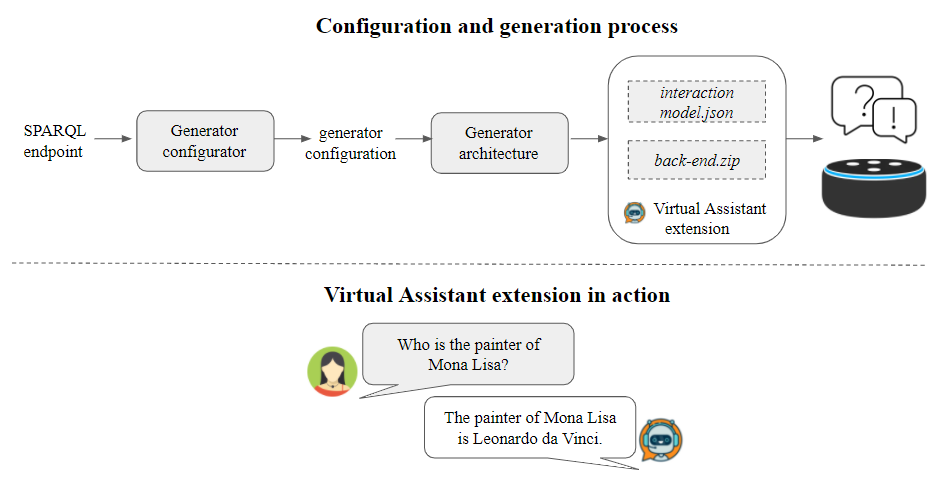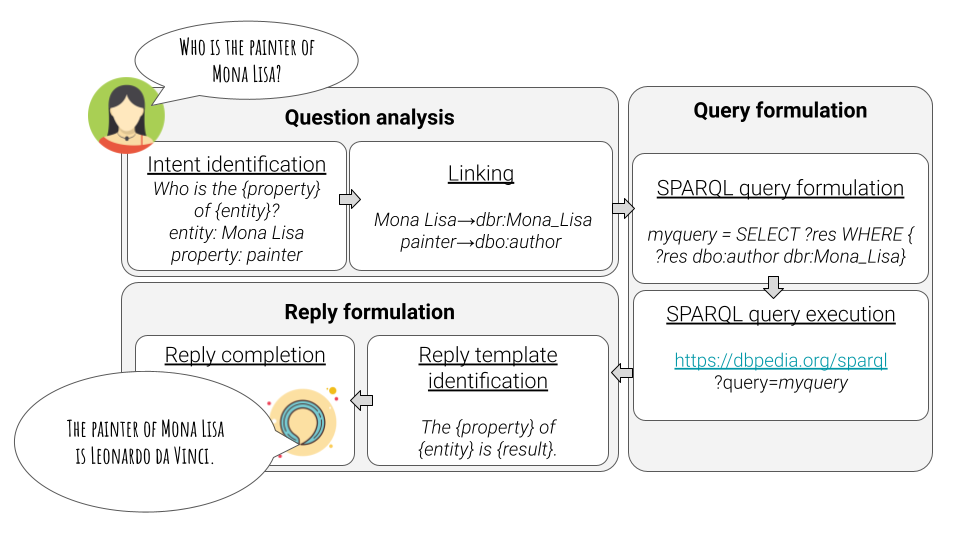Automatic Skill Generation for Knowledge Graph Question Answering
It is a webpage presenting a community shared software framework to create custom extensions to query knowledge graphs by virtual assistants, unlocking the potentialities of the Semantic Web technologies by bringing knowledge graphs in the “pocket” of everyone, accessible from smartphones or smart speakers.
The source code and documentation of the proposed generator is provided on GitHub and on Zenodo.
It represents an high-level process of the generation mechanism and example of the skill in action.

The generator architecture
The implemented process is graphically represented in figure.
 .
.
- The generator takes as input a configuration file, which defines:
- the SPARQL endpoint of interest
- desired language (en and it are supported at the moment)
- the invocation name (i.e., the skill wake-up word)
- the list of desired intents.
- entity and realtion dictionaries
- The generator checks the syntactical correctness of the configuration file during the syntax checker phase.
- It validates the semantic correctness of the configuration during the validation.
- During the interaction model generation, it creates the interaction_model.json which contains configured intents, its utterances and the slot values as defined in the configuration file.
- During the back-end generation phase, it produces the back-end (as ZIP file) containing the back-end logic implementation.
If any error occurs, the generator immediately stops and returns a message reporting the occurred error. If the configuration is properly provided, the generator returns a folder entitled as the skill wake-up word containing the interaction model as JSON file and the back-end Node.js code as a ZIP file. The generated skill is ready to be used, i.e., it can automatically be uploaded on Amazon developer and Amazon AWS, respectively. It corresponds to manually created skills, but our proposal may reduce required technical competencies and development time.
Supported intents
The implemented intents are tailored towards SPARQL constructs, and they cover SELECT and ASK queries, class specification, numeric filters, order by to get the superlative and path traversal.
We model each supported SPARQL query template as an intent. Each intent is modelled by a set of utterances and can be completed by slot values. A custom slot represents each slot, and it requires the specification of a (complete or partial) set of values that it can assume.
Configuration options: manual VS automatic
According to users’ skills, they can provide the generator with a custom configuration file. Otherwise, they can exploit the generator configuration component that takes as input the SPARQL endpoint of interest, automatically retrieves both classes and relations labels and their URIs, and returns the configuration file that can be directly used to initialize the VA generator.
Virtual Assistant Extension Usage

In a Virtual Assistant-based process (as in Fig.),
- Users pose a question in NL by pronouncing or typing it via a VA app or dedicated device (e.g., Alexa app/device);
- Virtual Assistants are provided with a Natural Language processing component performing the question analysis task, which includes
- intent identification to recognize the intent matching user’s request and solving intents slots;
- linking task to determine URIs corresponding to entities and relations labels. It can be accomplished by consulting a lookup dictionary or by calling an API service, at the moment.
- The Virtual Assistant extension back-end performs the query formulation task which is based on
- SPARQL query formulation to transform the user question in a SPARQL query,
- SPARQL query execution to run the SPARQL query over the configured SPARQL endpoint.
- The Virtual Assistant extension back-end performs the reply formulation task where
- the reply template identification phase aims to recognize the template to return the Natural Language reply,
- during the reply completition, the reply template is complited by actual results.
- The reply is returned to the user.
Use cases
we propose a generic approach and we openly publish Virtual Assistant extensions for general purpose KGs (such as DBpedia and Wikidata) and Cultural Heritage Knowledge Graphs. Use cases are available on GitHub and Zenodo.
Demo
A complete demo to use the generator and the generated skill on DBpedia is freely available.
Citation
This webpage behaves as a support material for the demo paper entitled Automatic Skill Generation for Knowledge Graph Question Answering, authored by Maria Angela Pellegrino, Mario Santoro, Vittorio Scarano, Carmine Spagnuolo (Univerità degli Studi di Salerno, Italy), at ESWC 2021.